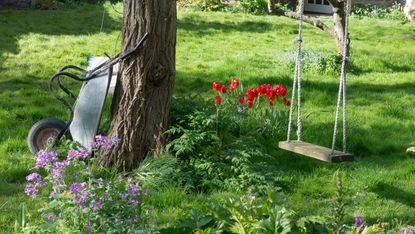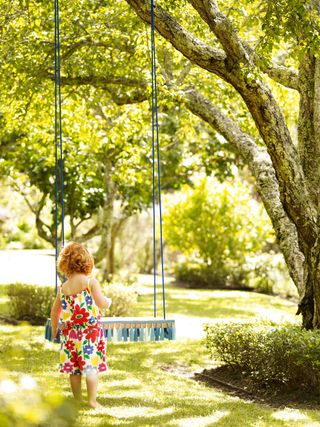How to hang a tree swing: advice for safely securing a swing from a branch
Our guide on how to hang a tree swing is just what you need to give kids hours of entertainment outdoors


Are you wondering how to hang a tree swing? Then you've come to the right place. They're a classic way to keep children happily occupied, but only if they're installed correctly and safely.
Not only are tree swings a great backyard feature if you're after garden activities for kids, but they're also relatively inexpensive too – often costing much less than swing sets suspended from frames. Visually, they're also less obvious in a garden, blending in more cohesively with the surrounding natural features.
Of course, the delight of gently swaying beneath a canopy of leaves isn't solely reserved for little ones, either. As the team at Solvej Swings say, 'Swings are wonderful. They provide stimulation and relaxation and the pop of fun in everyday life we all crave.'
You'll be pleased to know that putting one up isn't too tricky, as long as you've got the know-how. To help you on your way, we've brought together tons of advice on how to hang a tree swing below, along with plenty of top tips from the experts.

These stylish designs are from Solvej Swings
How to hang a tree swing: a simple guide
The experts from Solvej Swings share their advice on how to hang a tree swing:
- Ideally, you want to hang your swing from a branch that is horizontal to the ground. It must also be strong enough to take the weight without snapping.
- There are a few ways that you can attach the swing to the tree. One method is to drill straight through the branch and use eye-bolts and carbine clips (or carabiners). If you’re using carabiners, make sure the eyes of your bolt or screw and the carabiners are perpendicular to each other. This may feel counterintuitive, but it minimizes grinding and wear.
- Alternatively, you can use tree hangers; wide straps which wrap around the branch with minimal pressure.
- Some people choose to secure swings by wrapping rope directly around the branch. However, Solvej Swings don't recommend this; it can cut off the sap supply, which may in time kill the branch.
- To make sure it swings in a straight line, your top fastenings (eye-bolts or tree hangers, for instance) should be slightly further apart than the width of the swing. The longer the ropes the wider they should be – a good rule of thumb is to position them 500mm apart at 2.4m high, increasing by 10mm with each 50mm height increase.
- Swings should always be installed by someone competent. If in any doubt, call in a tradesperson, such as a tree surgeon, to take care of the installation for you.
- Check all ropes and attachments regularly for signs of wear or loosening. And, remember that it's always best to supervise children, especially younger ones, when they're using the swing.
If you're looking for more advice on how to design a child friendly garden, our dedicated guide is full of ideas.

A decorative swing can be a pretty feature for the garden and is tons of fun, too
How to hang a tree swing on an angled branch
Sometimes, you may not have the luxury of a sturdy branch that's horizontal to the ground for hanging your swing from. If your swing is the kind that just requires a single rope (for instance, a vertical tire swing) then this won't be a problem. But, for normal swings, attaching them to an angled branch can make them crooked.
When learning how to hang a tree swing, bear in mind that 'it's always best to try and find a branch that's as level as possible,' as says Simon Dean of Chorley Oak on Etsy, who creates handmade wooden swings. 'An angled branch will always mean uneven lengths of rope and the swing may track in an arc rather than straight.'
'If it's the only branch available then I'd recommend to hang the swing slightly further out from the trunk than normal to avoid collision,' he continues.
'The other problem with angled branches is slippage,' Simon says. If you've secured your swing by tying a rope around the branch, then the ropes will gradually try to wriggle their way down towards the trunk. 'This can be avoided one of two ways,' he adds. First, you can put an extra wrap of rope around the branch so it cinches down when in use (and still slackens when there's no load on it, allowing tree growth). Alternatively, you can fix the rope down to the top of the branch with a large 'U'-shaped nail. 'This goes over the rope, never through it,' he continues. 'It doesn't need to squash the rope, it's only there to prevent sideways movement.'
- If you want to bring even more fun to your backyard, then our treehouse ideas feature will provide tons of inspiration.

Angled branch? Don't worry, there's a few tricks you can try to secure a swing
How to hang a tree swing on a high branch
If you can't reach the branch easily, then it's always best to get a professional to hang the swing for you, especially if there's going to be drilling involved.
'It's more about safety concern than technique,' says Simon Dean of Chorley Oak. If you're happy to install it yourself, remember basic ladder safety. For instance, don't climb without somebody footing for you, and stabilize the ladder against the branch before you start working (ensuring the ladder is well-positioned, to avoid over-reaching or things getting in the way). Simon also suggests to have the swing rested at the desired height before you haul the ropes up, such as on a chair or stack of books. This avoids the temptation for whoever is helping you to leave the foot of the ladder to hold the swing seat up.
If you want to secure the swing simply by tying the rope directly around the branch, then you may not need a ladder. Bigyardfun.com have a trick you can use:
- Tie a ball or stone to a long piece of twine or string.
- Throw the weighted object (very carefully as not to hit anything or anyone in the process) up and over the high branch, holding on to the other end of the string as you do so.
- Tie your rope to the end of the string that you're still holding, then pull the other end of the string downwards, over the branch, so your rope is pulled upwards and over the branch, too. Both ends of rope should now be hanging either side of the branch.
- Tie a bowline knot in one end of the rope and slip the other end through it, then pull to secure it to the branch.

Keep the kids occupied for hours by learning how to hang a tree swing
What is the best place to hang a tree swing?
Swings make a lovely addition to family garden ideas, or alongside one of the best climbing frames. However, the team at Solvej Swings explain the need to consider strength and space when installing one.
In terms of strength, 'Whatever the swing hangs from needs to be structurally strong – strong enough to hold not only the weight of the swing and its occupant downwards, but also the multi-directional forces of swinging.' This means picking a branch that is healthy – free of disease and rot – and thick enough (generally around eight inches).
'There also needs to be enough space around the swing for it to swing without hitting anything around or above it,' adds Solvej Swings.
According to the experts at The Oak & Rope Company, you'll need to hang your tree swing at least three to five feet away from the trunk of the tree. They also suggest to install the swing a little higher (around 8–12 inches) than you might think – ropes tend to stretch a bit during the first use.
If your plot is lacking in trees but you'd still love to add a swing, then consider other options. With the appropriate hardware, your swing may also be hung from timber or concrete, says Solvej Swings. Popular choices include verandas, or why not introduce one to your pergola ideas?

A picture-perfect set-up, complete with a hammock
Shop tree swings for your garden or yard
Ready to add a fun activity for the kids (and adults!) to your outside space? Our guide to garden tree swings has plenty of stylish buys, or shop today's best deals below.

The garden was always a big part of Holly's life growing up, as was the surrounding New Forest where she lived. Her appreciation for the great outdoors has only grown since then. She's been an allotment keeper, a professional gardener, and a botanical illustrator – plants are her passion.
-
 An Update on Gardeningetc
An Update on GardeningetcA word from our publisher
By Beth Murton Published
-
 Do you need to chit potatoes? Find out what the experts say
Do you need to chit potatoes? Find out what the experts sayGrow Your Own Learn how to chit potatoes before planting them in the ground and you’ll be on your way to getting an earlier and bigger harvest
By Drew Swainston Published
